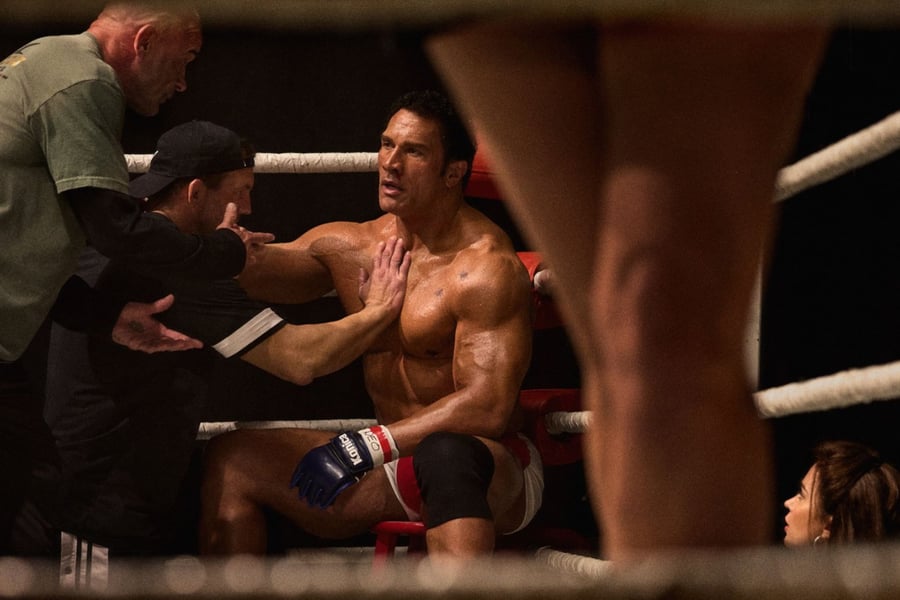With a title like The Smashing Machine, one might expect writer-director Benny Safdie’s first solo-directed feature to be a brutal, grinding sit. The film is based on the 2002 documentary of the same name about the life of Mark Kerr, one of the first American stars of mixed martial arts, a grueling sport. But rather than an intense portrait of MMA’s grunt and strain, The Smashing Machine is mellow, ruminative; it floats more than it stings.
Which is a welcome change of pace from how movies about professional fighters typically carry themselves. There is plenty of blood and grit in the film, but Safdie captures it all with a disarmingly light touch, sympathetically framing these beefed-up brawlers as working men just trying to make something of themselves. It’s a surprisingly amiable film; what you assume would be off-putting is, for the most part, curiously warm and inviting. But there is a fine line between low-key and undercooked, and it’s a line that The Smashing Machine crosses a bit too often. Safdie is so determined to keep his film at a low simmer that one occasionally wonders if he’s turned the stove on at all.
Kerr is played by Dwayne Johnson, the former professional wrestler turned action-comedy megastar, and in its pre-release buzz and marketing, the movie has been touted as an opportunity for Johnson to flex his dramatic muscles. Maybe, just maybe, he’ll pick up some award nominations as well. We’ve seen that kind of narrative play out many times before — an actor known for one thing turning that image on its head with some kind of revelatory transformation. But Safdie does not seem all that interested in giving Johnson big moments to play or scenes that could be used as Oscar clips. He keeps the histrionics at a minimum, instead further teasing out a softness that his star has often used to comic effect in his familiar gentle-giant routine.
Johnson has always been a bit slick in the promotion of his brand; there’s something smarmy and politician-ish about his attempts to appeal to as broad an audience as possible. There’s a little of that in the film’s version of Kerr, too, a solicitous, faintly slick politeness that one might not expect from a man who spends so much time beating up other people. But The Smashing Machine subtly reveals the humanity that’s just underneath Kerr’s carefully maintained affability; the film teaches us what is genuine about Kerr and what maybe isn’t. Johnson’s performance is humble rather than showy, an impressive feat of control and restraint.
Thankfully, Safdie creates the right environment to cultivate such delicate nuance. The film unfolds in a dreamy, meandering flow, following Mark around the world and into his home, gliding from the pressures of the octagon (where MMA athletes duke it out) to scenes of more quotidian domesticity. Composer Nala Sinephro’s score is a woozy jumble of alt-jazz, shuffling and lilting around Kerr as he steadfastly pursues his dream. It’s all rather enveloping but also, at times, almost soporific, lulling us into a sort of daze when, maybe, we should be held in suspense and alert.
Though Kerr’s work and his struggles with drug addiction and a rocky relationship are, of course, rather big and meaningful to him, the stakes of the film never feel very high. We don’t really gain an understanding of Kerr’s dogged passion. We are mostly just told that it’s there and asked to accept that. There’s little excitement in the film, which will probably disappoint some audience members who were hoping for a cool, neo-Rocky.
Safdie makes no effort to glamorize the Kerr’s work, or to insist that there is actually an elegance to what MMA fighters do. He depicts the sport — in its nascency in the late 1990s, when the film is largely set — as a fast, blunt clashing of two bodies. The locker rooms and antechambers behind the scenes are drab and plain. And yet, there is something compelling about these odd places, people, and customs. There’s the feeling that this is all just another day at the office, albeit one with enormous gladiators wandering around in the background.
Love Music?
Get your daily dose of everything happening in Australian/New Zealand music and globally.
One of Kerr’s colleagues, Mark Coleman, is played by real-life MMA fighter Ryan Bader, one of several non-professional actors who give The Smashing Machine the pleasing texture of lived-in credibility. (MMA star Bas Rutten, playing himself, is also a highlight.) Everyone is awfully friendly to one another, showing affection and respect for their mutual dedication and aspiration — it often seems that Bader and Rutten are generously welcoming Johnson, and the audience, into their world. One might expect Emily Blunt, playing Kerr’s girlfriend Dawn Staples, to disrupt that shaggy realism and bonhomie with her movie-star glow. But she naturally blends in with her surroundings, ably matching Johnson’s understated energy. Even when Kerr and Staples get in an argument that frighteningly escalates, both Blunt and Johnson maintain their relaxed equilibrium.
But, again, a few more fireworks might liven things up. The Smashing Machine is so chill that one begins to wonder why it’s a movie at all. A simple mood piece is all well and good, but some drama might help justify this particular film’s existence. It’s really only toward the very end when Safdie’s higher purpose emerges. He stages a moving scene of catharsis and resignation swirling together as the camera holds close on Kerr as he considers the undulating fortunes of his pursuit.
It’s hard not to think about Johnson himself in that moment, this actor who enjoyed a string of so many hits that he began to seem impervious. But there have been some career stumbles recently, a superhero disappointment in particular, that must have complicated Johnson’s conception of his remarkable career. Perhaps he, too, is experiencing something like acceptance, recognizing that setbacks do not wholly undo him but rather recommit him to his mission. It’s a poignant thought, one that darts in at the every end of Safdie’s laid-back ramble.
The Smashing Machine is hard to love, because its nebulous form offers so little to grab onto and hold tight. But there is a lot to be appreciated: the film’s sensitivity and modesty, its refusal to grandstand or sensationalize. Safdie may have found a new way to make a sports drama, one that relies less on the thrill of victory and the agony of defeat and more on all that is contained in the ambivalent middle. That is the real stuff of life, after all.
From Rolling Stone US



































